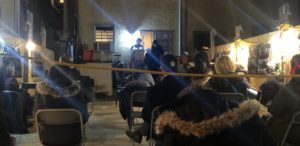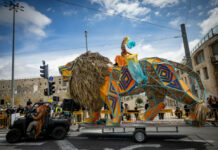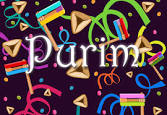
I was among a group of about 30 people who gathered for a Megillah reading on Feb. 25 at Chabad Young Philly at Broad and Catharine streets.
Billed as “COVID-friendly (unfriendly to the virus!),” the evening did indeed bear the indelible marks of the pandemic: masks, hand sanitizers, individually wrapped food and spaced seating. We were outside on a breezy night under a nearly full moon. Hot cider and hand warmers abounded, which created jugglers of us all, as the desire to warm oneself conflicted with the duty to follow along as the Megillah was read and to grogger away when appropriate. Soft yellow lights lined the backyard fence.
Aside from the story of Chanukah, the Book of Esther might be the Jewish story with the greatest distance between the text and its commentaries and the version taught to children.
Ahasuerus, in my Jewish day school education, was nothing more than a bumbler who loved two Jews, and then his Jewish subjects; Vashti’s head was simply separated from her crown, rather than from her entire body; and I can’t say I recall too much discussion of the Jews doing a preemptive strike on the goyim in each of the 127 provinces.
As I watched costumed children preparing to make all the sanctioned noise they could, I wondered if the last year had registered for them in the way that approaching the text of Esther as an adult did for me. Were stories about the competence and goodwill of the adults in charge revealed to be for children?
The Megillah reading was done with great speed, and the groggering was equally competent; rare was the premature grog. We heard about Haman, the wicked son of Hammedatha the Agagite himself, and we heard about the brave and beautiful Esther. We joined voices to read a few verses aloud together, and sang together when the reading was completed. We filed out of the backyard slowly at the conclusion, dropping off our Esther texts for sanitation and pocketing hamantaschen for the road. We were even sent on our way with mishloach manot, each in a bright purple box.
The whole affair was less than 40 minutes; there was some cleaning to be done, and two more shifts would be coming to hear the Megillah read that evening.
It feels good to write “we” when “we” refers to a group of people who were gathered together in person. It’s not something I’ve often had the privilege to do in the last year. It’s a “we” with depth because it is a “we” with roots in the real world. For an evening, “we” could think of ourselves as a group of people brought together by intention, rather than as a herd to be immunized, a voting bloc to be courted, camps to be unified or a data point in a spiking graph.
The writer Gabriel Winant posed some scary questions in an essay last December: Has the last year of savagely rendered isolation and violence revealed that we do not, as Margaret Thatcher once said, live in a society? Has the pandemic hastened the decline of our mutual sense of responsibility?
Impossible to answer. But at Chabad that night, I saw a group of people who answered in the negative, who seemed to say, in one voice, that “society” might not be something one can opt in or out of. It might just be an ecstatic state, one that requires lots of people to do small things together every day, until the feeling is as real as the hamantaschen in your hand.
[email protected]; 215-832-0740






